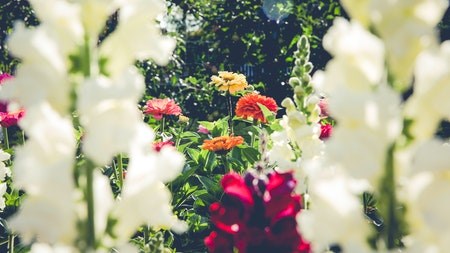Whether staying home or going away in December, now if the time to prepare your garden for the festive season. So, if you’re staying home and want a gorgeous show, complete planting out your summer seedlings and perennials early this month. If you are going away and there’s no one to water your garden for you, mulch the beds to conserve moisture and let your garden rest.
Gardening in South Africa offers some tips for creating a sleek and colourful garden in time for the holidays.
First, a tidy garden always leaves a good impression. If your outdoor space has become a rambling and weedy muddle, start by giving it a good spring clean and pruning.
If you plan to revamp an established garden, work with the existing plants, add plants that will enhance the design and remove those that really clash.
Lawns
A beautiful, healthy lawn goes a long way to creating a chic garden. However, lawns need regular attention throughout the growing season, so if you want a good-looking lawn for December, continue to feed and water regularly with a slow-release organic fertiliser designed for lawns.
On most soils, lawns require watering to a depth of about 30cm each week. Measure how much water your irrigation system is delivering and save water by adjusting as required. Try to water in the morning so the blades can dry off during the day to help prevent fungal diseases. This applies especially to Kikuyu lawns which are susceptible to 'fade out' - a fungal disease.
For a fine textured lawn with no yellow spots, mow frequently but don’t cut it too short. Mow your lawn during the cooler part of the afternoon if possible. Also, periodically change the direction you mow your lawn in to prevent ridges and uneven growth.
If moles are a problem, continued use of a garlic-based repellent should hopefully chase them away.
Colour
Colour helps to lead the eye through the garden. It draws attention to focal points and ties together other landscaping elements, like background trees and shrubs or stretches of lawn.
Colour will also soften or accentuate low walls and pathways and can demarcate various ‘rooms’ in the garden. For a tranquil look, stick to a simple scheme with just a few colours.
The large selection of flowering bedding plants available in South Africa enables us to have colour in our gardens throughout the year. Bedding plants gives you the opportunity to incorporate a fresh new look every season with different plant varieties and colour schemes. Combine these with the fast-maturing versatility of annuals, and your garden will be a canvas with you being the artist.
Decide where some colour will be most effective in your garden, and visit your garden centre to select annuals and perennials that flower well in December. Remember that perennials will provide colour for many seasons, saving you money in the long run.
Seeds are inexpensive, and there is still time to sow seeds of fast-maturing, water-wise annuals like: salvia, portulaca, marigolds, cosmos, nasturtiums, ageratum and zinnias.
If you want a display in December, it may be best to look for reasonably well-developed flower seedlings rather than trying to grow everything from seed. Before planting out seedlings, dig plenty of compost into the beds and sprinkle it with bone meal. The best time to plant is late afternoon when it is cooler, giving the small plants time to revive before the morning heat.
Continually pinch out the dead flower heads of your annuals to prolong flowering. Cut back the dead flowering spikes of foxgloves and delphiniums and feed them with organic 3:1:5. This will encourage plants to put forth side shoots, and they will flower again later in summer.
Roses
The first summer flush of roses is almost over, so it's time to neaten bushes by removing the dead blooms. This will encourage re-blooming. Cut back to a dormant bud pointing in the direction where you want the new shoot to grow. Let as many leaves remain on the plant as possible. Roses need plenty of healthy leaves to protect the stems against sunburn.
Continue to remove any briar growth, which normally shoots from the bottom of the plant. You can notice briar growth immediately as water shoots grow very vigorously and look different from normal shoots.
Regularly spray roses with an organic insecticide and a fungicide. However, don’t apply them simultaneously – instead, spray one in the morning, then spray the other in the evening. Be on the lookout for powdery mildew, black spot, aphids and red spider mites. Feed the roses with an organic 8:1:5 fertiliser and water deeply at least twice a week during dry spells.
Summer pruning
Prune rambling roses and frost hardy shrubs and climbers that flowered in spring and early summer like Abelia, Deutzia, Cape May (Spiraea arguta and cantoniensis), Forsythia, Mock Orange (Philadelphus), Weigelia, Jasmine, and the Snowball Bush (Viburnum).
In hot, dry regions, don’t prune too harshly. Mature plants can be cut back about one-third.
Bougainvilleas can also be pruned when the first flush of flowering bracts has faded. Remove any water shoots that grow from the base of the plant.
Prune marguerite daisy bushes (Argyranthemum) and Chrysanthemums after their first flush of flowers to encourage them to bush out and produce more blooms.
Beetles
Watch out for the large yellow and black CMR beetles on your flowering plants. They become active in October, and populations peak in summer. As a result, many garden plants can come under attack - especially roses - and just one beetle can destroy many blooms in a single day. The flowers of vegetables like pumpkins, tomatoes and beans are also susceptible.
If only a few beetles are spotted, you can catch them by hand, but be sure to wear gloves because they excrete a liquid that can cause blisters. Severe infestations can be controlled with any organic formulation that contains pyrethrins. The best control is obtained by thoroughly spraying the adult beetles while they are actively feeding on warm days. Adding a wetter or sticker to the spray solution will increase its effectiveness.
Feeding
Continue to feed hydrangeas regularly with hydrangea food, to intensify the colour of the blooms. Mulch them with bark chips or compost to conserve water, and water regularly for a spectacular show in December.
Fuchsias can also look at their best in December if they are well cared for now. Continue to feed and water regularly, but be careful not to overwater. On very hot days, fuchsias may wilt even though the soil is still wet. If they are in containers, try moving them to a cooler position or simply spray the leaves down with water, and they will quickly perk up again in the evening. Regularly spritzing the underside of leaves with water will also help keep red spider mites and whiteflies at bay. Spray early in the day so the leaves are dry before evening; otherwise, they may be more susceptible to powdery mildew.
Bulbs
If you have not yet lifted and divided your winter and spring flowering bulbs to store for next season, you should still be able to do so this month.
Plant amaryllis bulbs out now to have them in full bloom in time for Christmas. Feed summer bulbs like cannas, dahlias, liliums and Gladioli - and stake your liliums. Check all your bulbs for lily borer and treat with Margaret Roberts Biological Caterpillar Insecticide if needed.
Lift and divide bearded irises now if necessary. Discard the rhizomes which produced the flowers and replant only the young pieces into good, well-drained soil to which a sprinkling of agricultural lime has been added. Remove all dead leaves and check for snails. Always plant the rhizomes, so they are just showing above the ground.
Plant some more summer flowering bulbs - especially dahlias - as staggered planting ensures many months of blooms. Also, if dahlia tubers are planted this month, they will bloom in February when the weather begins to cool down, and the blooms will last longer. Bedding dahlias are grown from seed and are available in seed packets as well as in seedling trays. Plant dahlias in good, well-drained soil and remember to plant a stake with the tuber for tall-growing varieties. If powdery mildew is spotted, spray immediately with an organic fungicide.
Summer rainfall regions
Water your garden thoroughly during dry spells.
If shrubs and roses are damaged by hailstorms, prune out the damaged wood and spray with a fungicide to prevent infections.
Ensure that all young trees and standard roses are securely staked to prevent storm damage.
In warmer regions, prune hibiscus, poinsettias and tibouchinas to encourage late summer and autumn flowering.
Make your last sowings of eggplant, sweet peppers, chillies and tomatoes. Try some globe artichokes, green mealies and sweetcorn this season. If you have space, plant potato and sweet potato tubers. If not, try growing them in a large barrel or a dustbin. Asparagus, beetroot, bush and runner beans, celery, cucumbers, pumpkin, squash, Swiss chard and lettuce can also still be planted.
Winter rainfall regions
Water your garden during the coolest part of the day. Buffalo lawns require less water and fertiliser than Kikuyu. Thorough watering twice a week is more than enough for established shrubs and trees. Seedlings and potted plants can be watered more frequently.
Save water by replacing some of your lawn with hard landscaping materials like pavers, gravel, pebbles or mulch. A cooler alternative is to plant more groundcovers that act as living mulch.
Ensure that your bird bath is always filled with clean water.
Prune fynbos plants like buchu, confetti bushes and indigenous daisies that have finished flowering.
Take softwood cuttings of Arctotis and osteospermums.
It’s not too late to sow seeds of fast-maturing summer annuals or to plant out summer seedlings. Before you pull out Namaqualand daisies, Shirley poppies, felicias and forget-me-nots, collect seeds to store for sowing next season.
Continue to sow or plant summer vegetables like carrots, beetroot, eggplant, sweet peppers, tomatoes, green mealies and sweet corn, pumpkin and squash. Try sowing some spanspek and watermelon. Feed berries with a slow release 3:1:5 and spray grape vines regularly to prevent fungal diseases like powdery mildew.
Subtropical regions
November is a rainy month in these regions, so fertilise your garden regularly with a balanced fertiliser like 2:3:2 or 3:1:5.
Feed lawns with a balanced fertiliser high in nitrogen, like 7:1:3. Remember to properly seal fertiliser packets or containers after use to prevent them from becoming mouldy.
Continue to regularly spray plants that are susceptible to fungal diseases with an organic fungicide.
Check palm trees for rhino beetles that bore into the heart of palms and cause the crown to die off.
Check trees and tree ferns for white ants. If you see what looks like mud on the trunks, treat them with an appropriate commercial ant spray. Alternatively, dilute three tablespoons of Jeyes Fluid in five litres of water and spray thoroughly.
Remove old, dead crowns from your bromeliads and feed them with 3:1:5. Blast the stagnant water out of the centre of plants as mosquitoes may breed there.
Fertilise cannas and marantas and water well.
Prune out old dead palm tree fronds and feed palms with a nitrogen-rich fertiliser.
Let your garden blossom and bloom this November by applying the tips provided above.
Writer : Sarah-Jane Meyer




